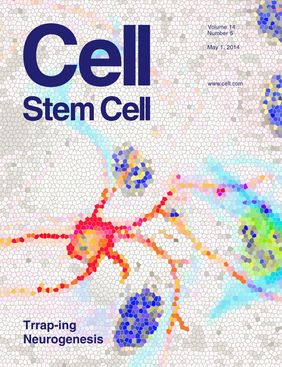During embryonic brain development, neural stem cells pass through a series of tightly regulated stages: from omnipotent stem cell to specialized progenitor capable of producing only certain types of neurons or support cells. If the timing of any of these transitions is just slightly off, it will result in substantial changes in the total number of neurons and ultimately overall brain size. “The correct timing of fate decisions by neuronal stem cells is fundamental for building the necessary fine brain architecture,” explains Zhao-Qi Wang, Ph.D., the study’s senior author.
Wang and this team discovered that Trrap, a protein better known for its general role in facilitating the gene expression machinery’s access to DNA, prevents actively dividing neural progenitors from dawdling. Without Trrap, dividing cells slow down—loosing their ability for self-renewal and differentiating into neurons prematurely. “By maintaining the balance between self-renewal and differentiation of neural progenitors, Trrap ensures the availability of enough neuron-producing progenitors to build a healthy brain,” says Wang.
When genes are turned on to serve as templates for proteins, the tightly wound DNA must unfurl just enough to allow the machinery that reads the encoded genetic information to slip in. Their access is mainly regulated through enzymes that add small chemical flags to the histone spools that keep the DNA inside a cell’s nucleus neatly organized. One of the best-studied modifications is the addition of acetyl groups, which is catalyzed by an enzyme known as histone acetyltransferase or HAT, for short. Trrap is its well-known and indispensible helpmate.
These histone modifications—often referred to as epigenetic changes—play an important role in creating distinct patterns of gene expression essential for self-renewal and differentiation of stem cells but the details are still somewhat unclear. “We still know very little about the specific molecular mechanisms that link epigenetic patterns to the fate of stem cells,” explains postdoctoral researcher and lead author Alicia Tapias, Ph.D.
To learn more, she generated mice that lacked Trrap only in the central nervous system. A first exam of the newborn mice revealed severe developmental defects in the brain. Their brains were about 40 percent smaller, with fewer dividing cells and increased cell death in the cortex—the largest brain structure and seat of higher cognitive functions.
When she followed the fate of neuronal progenitors during embryonic development, it quickly became clear that a highly proliferative subpopulation of neural progenitors known as apical progenitors, prematurely differentiated into basal progenitors, which are capable of generating neurons but, at least in mice, are unable to proliferate.
A genome-wide analysis of gene expression of Trrap-deficient cells brought the research team a step closer to pinpointing the reasons behind the apical progenitors’ change of fate: Deleting Trrap specifically lowered the expression of cell cycle genes, most prominently those governed by E2F, a family of well known cell cycle regulators.
“When we measured cell cycle length in apical progenitors lacking Trrap it was twice as long as in normal control cells, while cycle length in basic progenitors was only slightly delayed,” says Tapias. Overexpression of cell cycle activators Cyclin A2 and Cyclin B1 in Trrap-deficient neural progenitors brought them back up to speed and prevented those cells from differentiating prematurely.
“Our experiments highlight that HAT regulates a specific group of cell cycle genes,” explains Wang and adds that, “this information may shed light on understanding of the epigenetic modulation in neurological behavior and cell fate of adult stem cells in our brains.”
Publication
Tapias A, Zhou ZW, Shi Y, Chong Z, Wang P, Groth M, Platzer M, Huttner W, Herceg Z, Yang YG, Wang ZQ. Trrap-dependent histone acetylation specifically regulates cell cycle gene transcription to control neural progenitor fate decisions. Cell Stem Cell (2014). Doi: dx.doi.org/10.1016/j.stem.2014.04.001
On the cover: Tapias et al. (632–643) describe a key role for the histone acetyltransferase cofactor Trrap in neurogenesis via regulation of cell cycle gene activation. The cover image depicts the process of neurogenesis using an adapted experimental image and was inspired by the artistic style of Gaudí. Image kindly provided by Alicia Tapias. [Source: Cell Stem Cell 2014, Volume 14, Issue 5, May 01, 2014]









